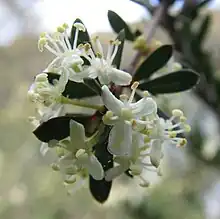Micrantheum hexandrum
Micrantheum hexandrum, commonly known as box micrantheum,[2] is a species of flowering plant in the family Picrodendraceae and is endemic to eastern Australia. It is an erect, monoecious shrub with oblong to narrowly lance-shaped leaves, and small white flowers with six or nine stamens. Picrodendraceae.
| Micrantheum hexandrum | |
|---|---|
 | |
| Micrantheum hexandrum Mount Buffalo National Park, Victoria | |
| Scientific classification | |
| Kingdom: | Plantae |
| Clade: | Tracheophytes |
| Clade: | Angiosperms |
| Clade: | Eudicots |
| Clade: | Rosids |
| Order: | Malpighiales |
| Family: | Picrodendraceae |
| Genus: | Micrantheum |
| Species: | M. hexandrum |
| Binomial name | |
| Micrantheum hexandrum | |
| Synonyms[1] | |
| |
Description
Micrantheum hexandrum is an erect, monoecious, more or less glabrous shrub that typically grows to a height of about 2 m (6 ft 7 in). The leaves are oblong to narrowly lance-shaped or lance-shaped, with the narrower end towards the base, 8–15 mm (0.31–0.59 in) long and 2–3 mm (0.079–0.118 in) wide with a small point on the tip. Male flowers are borne on a peduncle about 8 mm (0.31 in) long, the sepals egg-shaped and 1–3 mm (0.039–0.118 in) long, and have six or nine stamens. Female flowers are more or less sessile, the sepals lance-shaped to egg-shaped and 3–5 mm (0.12–0.20 in) long. Flowering mostly occurs from October to February, and the fruit is an oval to spherical capsule 6–7 mm (0.24–0.28 in) long.[2][3][4][5]
Taxonomy
Micrantheum hexandrum was first formally described in 1847 by Joseph Dalton Hooker in the London Journal of Botany from specimens collected near Launceston.[6][7] The specific epithet (hexandrum) means "six stamens".[8]
Distribution and habitat
Box micrantheum grows on rocky sites and near watercourses, often at higher altitudes, from south-eastern Queensland, along the coast and tablelands of New South Wales to scattered places in eastern Victoria and to eastern Tasmania.[2][3][4][5][9]
References
- "Micrantheum hexandrum". Australian Plant Census. Retrieved 15 September 2023.
- Jeanes, Jeff A.; Stajsic, Val. "Micrantheum hexandrum". Royal Botanic Gardens Victoria. Retrieved 15 September 2023.
- James, Teresa A.; Harden, Gwen J. "Micrantheum hexandrum". Royal Botanic Grden Sydney. Retrieved 15 September 2023.
- Robinson, Les (1991). Field Guide to the Native Plants of Sydney. Kenthurst, N.S.W.: Kangaroo Press. p. 167. ISBN 0864171927.
- Fairley, Alan; Moore, Philip (2010). Native Plants of the Sydney Region. Crows Nest, N.S.W.: Jacana Books. p. 118. ISBN 9781741755718.
- "Micrantheum hexandrum". APNI. Retrieved 15 September 2023.
- Hooker, Joseph D. (1847). "Florae Tasmaniae Spicilegium: or, Contributions towards a Flora of Van Diemen's Land". London Journal of Botany. 6: 283–284. Retrieved 15 September 2023.
- Sharr, Francis Aubi; George, Alex (2019). Western Australian Plant Names and Their Meanings (3rd ed.). Kardinya, WA: Four Gables Press. p. 217. ISBN 9780958034180.
- Jordan, Greg. "Micrantheum hexandrum". University of Tasmania. Retrieved 15 September 2023.